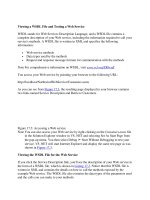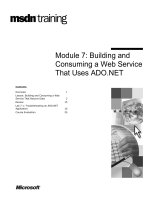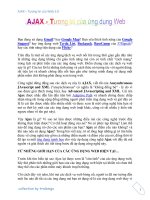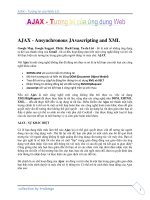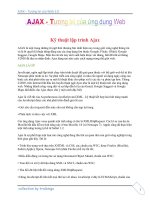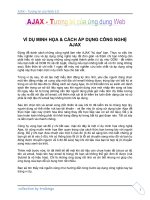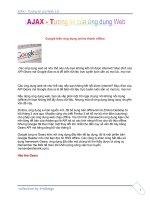Ajax.and.PHP_Building.Responsive.Web.Applications_Packt_2006
Bạn đang xem bản rút gọn của tài liệu. Xem và tải ngay bản đầy đủ của tài liệu tại đây (5.58 MB, 286 trang )
AJAX and PHP
Building Responsive Web Applications
Enhance the user experience of your PHP website
using AJAX with this practical tutorial featuring detailed
case studies
Cristian Darie
Bogdan Brinzarea
Filip Cherecheş-Toşa
Mihai Bucica
BIRMINGHAM - MUMBAI
AJAX and PHP
Building Responsive Web Applications
Copyright © 2006 Packt Publishing
All rights reserved. No part of this book may be reproduced, stored in a retrieval system, or
transmitted in any form or by any means, without the prior written permission of the publisher,
except in the case of brief quotations embedded in critical articles or reviews.
Every effort has been made in the preparation of this book to ensure the accuracy of the
information presented. However, the information contained in this book is sold without warranty,
either express or implied. Neither the authors, Packt Publishing, nor its dealers or distributors will
be held liable for any damages caused or alleged to be caused directly or indirectly by this book.
Packt Publishing has endeavored to provide trademark information about all the companies and
products mentioned in this book by the appropriate use of capitals. However, Packt Publishing
cannot guarantee the accuracy of this information.
First published: March 2006
Production Reference: 1210206
Published by Packt Publishing Ltd.
32 Lincoln Road
Olton
Birmingham, B27 6PA, UK.
ISBN 1-904811-82-5
www.packtpub.com
Cover Design by
www.visionwt.com
Credits
Authors
Cristian Darie
Brinzarea Bogdan
Filip Cherecheş-Toşa
Mihai Bucica
Reviewers
Emilian Balanescu
Paula Badascu
Technical Editor
Jimmy Karumalil
Editorial Manager
Dipali Chittar
Development Editor
Cristian Darie
Indexer
Ashutosh Pande
Proofreader
Chris Smith
Production Coordinator
Manjiri Nadkarni
Cover Designer
Helen Wood
About the Authors
Cristian Darie
is a software engineer with experience in a wide range of modern technologies,
and the author of numerous technical books, including the popular "Beginning E-Commerce"
series. Having worked with computers since he was old enough to press the keyboard, he initially
tasted programming success with a first prize in his first programming contest at the age of 12.
From there, Cristian moved on to many other similar achievements, and now he is studying
distributed application architectures for his PhD degree. He always loves hearing feedback about
his books, so don't hesitate dropping a "hello" message when you have a spare moment. Cristian
can be contacted through his personal website at
www.cristiandarie.ro
.
Cristian would like to express a big "thank you!" to his co-authors, Bogdan, Filip, and Mihai
and to the Technical Editor of the book, Jimmy, for the hard work they've put into building
this wonderful book.
Bogdan Brinzarea
has a strong background in Computer Science holding a Master and
Bachelor Degree at the Automatic Control and Computers Faculty of the Politehnica University of
Bucharest, Romania and also an Auditor diploma at the Computer Science department at Ecole
Polytechnique, Paris, France.
His main interests cover a wide area from embedded programming, distributed and mobile
computing, and new web technologies. Currently, he is employed as an Alternative Channels
Specialist at Banca Romaneasca, Member of National Bank of Greece, where he is responsible for
the Internet Banking project and coordinates other projects related to security applications and
new technologies to be implemented in the banking area.
Filip Cherecheş-Toşa
is a web developer with a firm belief in the future of web-based software.
He started his career at the age of 9, when he first got a Commodore 64 with tape-drive.
Back home in Romania, Filip runs a web development company named eXigo
www.exigo.ro
,
which is actively involved in web-based application development and web design. He is currently
a student at the University of Oradea, studying Computer Science, and also an active member of
the Romanian PHP Community
www.phpromania.net
.
Mihai Bucica
started programming and competing in programming contests (winning many
of them), all at age twelve. With a bachelor's degree in computer science from the Automatic
Control and Computers Faculty of the Politehnica University of Bucharest, Romania, Bucica
works on building communication software with various electronic markets.
Even after working with a multitude of languages and technologies, Bucica's programming
language of choice remains C++, and he loves the LGPL word. Mihai also co-authored
Beginning
PHP 5 and MySQL E-Commerce
and he can be contacted through his personal website,
www.valentinbucica.ro
.
About the Reviewers
Emilian Balanescu
is a programmer experienced in many technologies, including PHP, Java,
.NET, PostgreSQL, MS SQL Server, MySQL, and others. He currently works as a Wireless
Network Administrator at accessNET International S.A. Romania, a company that provides fixed
wireless access services operating a point-to-multipoint digital radio communication network with
national coverage. His latest project in this position was developing an AJAX-enabled real-time
Network Management System (using SNMP, Perl, PHP, and PostgreSQL) used for remote
debugging, monitoring system performance, and isolating and troubleshooting system problems.
You can reach Emilian at
.
Paula Badascu
is in the third year of studies at Politehnica University of Bucharest, one of the
most famous technical universities in Romania, studying Electronics, Telecommunications, and
Information Technology. Paula is currently working as an analyst/programmer for NCH Advisors
Romania, building web applications using UML, OOP, PHP, SQL, JavaScript, and CSS. She
contributed decisively to the analysis and development of a framework used for tracking and
monitoring the Romanian capital market.
Table of Contents
Preface 1
Chapter 1: AJAX and the Future of Web Applications 7
Delivering Functionality via the Web 8
Advantages of Web Applications 9
Building Websites Since 1990 10
HTTP and HTML 10
PHP and Other Server-Side Technologies 11
JavaScript and Other Client-Side Technologies 12
What's Been Missing? 13
Understanding AJAX 14
Building a Simple Application with AJAX and PHP 18
Time for Action—Quickstart AJAX 21
Summary 28
Chapter 2: Client-Side Techniques with Smarter JavaScript 29
JavaScript and the Document Object Model 30
Time for Action—Playing with JavaScript and the DOM 32
JavaScript Events and the DOM 33
Time for Action—Using JavaScript Events and the DOM 35
Even More DOM 37
Time for Action—Even More DOM 37
JavaScript, DOM, and CSS 39
Time for Action—Working with CSS and JavaScript 39
Using the XMLHttpRequest Object 42
Creating the XMLHttpRequest Object 43
Creating Better Objects for Internet Explorer 45
Initiating Server Requests Using XMLHttpRequest 46
Handling Server Response 49
Time for Action—Making Asynchronous Calls with XMLHttpRequest 50
Table of Contents
Working with XML Structures 55
Time for Action—Making Asynchronous Calls with XMLHttpRequest and XML 55
Handling More Errors and Throwing Exceptions 59
Creating XML Structures 63
Summary 64
Chapter 3: Server-Side Techniques with PHP and MySQL 65
PHP and DOM 65
Time for Action—Doing AJAX with PHP 66
Passing Parameters and Handling PHP Errors 71
Time for Action—Passing PHP Parameters and Error Handling 72
Connecting to Remote Servers and JavaScript Security 79
Time for Action—Connecting to Remote Servers 81
Using a Proxy Server Script 85
Time for Action—Using a Proxy Server Script to Access Remote Servers 86
A Framework for Making Repetitive Asynchronous Requests 91
Time for Action—Implementing Repetitive Tasks 93
Working with MySQL 101
Creating Database Tables 101
Manipulating Data 104
Connecting to Your Database and Executing Queries 105
Time for Action—Working with PHP and MySQL 106
Wrapping Things Up and Laying Out the Structure 109
Time for Action—Building the Friendly Application 112
Summary 119
Chapter 4: AJAX Form Validation 121
Implementing AJAX Form Validation 122
Thread-Safe AJAX 125
Time for Action—AJAX Form Validation 126
Summary 144
Chapter 5: AJAX Chat 145
Introducing AJAX Chat 145
Implementing AJAX Chat 147
Time for Action—Ajax Chat 148
Summary 164
ii
Table of Contents
Chapter 6: AJAX Suggest and Autocomplete 165
Introducing AJAX Suggest and Autocomplete 165
Google Suggest 166
Implementing AJAX Suggest and Autocomplete 167
Time for Action—AJAX Suggest and Autocomplete 168
Summary 188
Chapter 7: AJAX Real-Time Charting with SVG 189
Implementing a Real-Time Chart with AJAX and SVG 190
Time for Action—Building the Real-Time SVG Chart 193
Summary 202
Chapter 8: AJAX Grid 203
Implementing the AJAX Grid Using Client-Side XSLT 204
Time for Action—AJAX Grid 205
Summary 221
Chapter 9: AJAX RSS Reader 223
Working with RSS 223
The RSS Document Structure 224
Google Reader 224
Implementing the AJAX RSS Reader 225
Time for Action—Building the RSS Reader Application 226
Summary 236
Chapter 10: AJAX Drag and Drop 237
Using Drag and Drop on the Web 237
Shopping Carts 237
Sortable Lists 238
Building the AJAX Drag-and-Drop Sortable List Application 238
Time for Action—Task Management Application with AJAX 241
Summary 253
Appendix A: Preparing Your Working Environment 255
Preparing Your Windows Playground 256
Installing Apache 256
Installing MySQL 258
Installing PHP 259
iii
Table of Contents
Preparing Your *nix Playground 261
Installing Apache 261
Installing MySQL 261
Installing PHP 262
Installing phpMyAdmin 263
Preparing the AJAX Database 264
Index 267
iv
Preface
AJAX is a complex phenomenon that means different things to different people. Computer users
appreciate that their favorite websites are now friendlier and feel more responsive. Web
developers learn new skills that empower them to create sleek web applications with little effort.
Indeed, everything sounds good about AJAX!
At its roots, AJAX is a mix of technologies that lets you get rid of the evil page reload, which
represents the dead time when navigating from one page to another. Eliminating page reloads is
just one step away from enabling more complex features into websites, such as real-time data
validation, drag and drop, and other tasks that weren't traditionally associated with web
applications. Although the AJAX ingredients are mature (the
XMLHttpRequest
object, which is
the heart of AJAX, was created by Microsoft in 1999), their new role in the new wave of web
trends is very young, and we'll witness a number of changes before these technologies will be
properly used to the best benefit of the end users. At the time of writing this book, the "AJAX"
name is about just one year old.
AJAX isn't, of course, the answer to all the Web's problems, as the current hype around it may
suggest. As with any other technology, AJAX can be overused, or used the wrong way. AJAX
also comes with problems of its own: you need to fight with browser inconsistencies,
AJAX-specific pages don't work on browsers without JavaScript, they can't be easily
bookmarked by users, and search engines don't always know how to parse them. Also, not
everyone likes AJAX. While some are developing enterprise architectures using JavaScript,
others prefer not to use it at all. When the hype is over, most will probably agree that the middle
way is the wisest way to go for most scenarios.
In
AJAX and PHP: Building Responsive Web Applications, we took a pragmatic and safe approach
by teaching relevant patterns and best practices that we think any web developer will need sooner
or later. We teach you how to avoid the common pitfalls, how to write efficient AJAX code, and
how to achieve functionality that is easy to integrate into current and future web applications,
without requiring you to rebuild the whole solution around AJAX. You'll be able to use the
knowledge you learn from this book right away, into your PHP web applications.
We hope you'll find this book useful and relevant to your projects. For the latest details and
updates regarding this book, please visit its mini-site at
.
The book's mini-site also contains additional free chapters and resources, which we recommend
you check out when you have the time.
Preface
What This Book Covers
Chapter 1
:
AJAX and the Future of Web Applications is an initial incursion into the world of
AJAX and the vast possibilities it opens up for web developers and companies, to offer a better
experience to their users. In this chapter you'll also build your first AJAX-enabled web page,
which will give you a first look of the component technologies.
Chapter 2
:
Client-Side Techniques with Smarter JavaScript will guide you through the
technologies you'll use to build AJAX web clients, using JavaScript, the DOM, the
XMLHttpRequest
object, and XML. While not being a complete tutorial for these technologies, you'll be put on the
right track for using them together to build a solid foundation for your future applications.
Chapter 3: Server-Side Techniques with PHP and MySQL completes the theoretical foundation by
presenting how to create smart servers to interact with your AJAX client. You'll learn various
techniques for implementing common tasks, including handling basic JavaScript security and
error-handling problems.
Chapter 4: AJAX Form Validation guides you through creating a modern, responsive, and secure
form validation system that implements both real-time AJAX validation and server-side validation
on form submission.
Chapter 5: AJAX Chat presents a simple online chat that works exclusively using AJAX code, without
using Java applets, Flash code, or other specialized libraries as most chat applications do these days.
Chapter 6: AJAX Suggest and Autocomplete builds a Google Suggest-like feature, that helps you
quickly find PHP functions, and forwards you to the official help page for the chosen function.
Chapter 7: AJAX Real-Time Charting with SVG teaches you how to implement a real-time
charting solution with AJAX and SVG. SVG (Scalable Vector Graphics) is a text-based graphics
language that can be used to draw shapes and text.
Chapter 8: AJAX Grid teaches you how to build powerful AJAX-enabled data grids. You'll learn
how to parse XML documents using XSLT to generate the output of your grid.
Chapter 9: AJAX RSS Reader uses the SimpleXML PHP library, XML, and XSLT to build a
simple RSS aggregator.
Chapter 10: AJAX Drag and Drop is a demonstration of using the script.aculo.us framework to
build a simple list of elements with drag-and-drop functionality.
Appendix A: Preparing Your Working Environment teaches you how to install and configure the
required software: Apache, PHP, MySQL, phpMyAdmin. The examples in this book assume that
you have set up your environment and sample database as shown here.
At the book's mini-site at
, you can find the online demos for
all the book's AJAX case studies.
2
Preface
What You Need for This Book
To go through the examples of this book you need PHP 5, a web server, and a database server. We
have tested the code under several environments, but mostly with the Apache 2 web server, and
MySQL 4.1 and MySQL 5 databases.
You can choose, however, to use another web server, or another database product, in which case
the procedures presented in the chapters might not be 100% accurate. It is important to have PHP
5 or newer, because we use some features, such as Object Oriented Programming support, which
aren't available in older versions.
Please read Appendix A for more details about setting up your machine. If your machine already
has the required software, you still need to read the final part of Appendix A, where you are
instructed about creating a database that is used for the examples in this book.
Conventions
In this book, you will find a number of styles of text that distinguish between different kinds of
information. Here are some examples of these styles, and an explanation of their meaning.
There are three styles for code. Code words in text are shown as follows: "We can include other
contexts through the use of the
include
directive."
A block of code will be set as follows:
// function calls the server using the XMLHttpRequest object
function process()
{
// retrieve the name typed by the user on the form
name = document.getElementById("myName").value;
// execute the quickstart.php page from the server
xmlHttp.open("GET", "quickstart.php?name=" + name, false);
// make synchronous server request
xmlHttp.send(null);
// read the response
handleServerResponse();
}
When we wish to draw your attention to a particular part of a code block, the relevant lines or
items will be made bold:
// function calls the server using the XMLHttpRequest object
function process()
{
// retrieve the name typed by the user on the form
name = document.getElementById("myName").value;
// execute the quickstart.php page from the server
xmlHttp.open("GET", "quickstart.php?name=" + name, false);
// make synchronous server request
xmlHttp.send(null);
// read the response
handleServerResponse();
}
3
Preface
Any command-line input and output is written as follows:
./configure --prefix=/usr/local/apache2 --enable-so --enable-ssl --with-
ssl --enable-auth-digest
New terms and important words are introduced in a bold-type font. Words that you see on the
screen, in menus or dialog boxes for example, appear in our text like this: "clicking the
Next
button moves you to the next screen".
Warnings or important notes appear in a box like this.
Tips and tricks appear like this.
Reader Feedback
Feedback from our readers is always welcome. Let us know what you think about this book, what
you liked or may have disliked. Reader feedback is important for us to develop titles that you
really get the most out of.
To send us general feedback, simply drop an email to
, making sure to
mention the book title in the subject of your message.
If there is a book that you need and would like to see us publish, please send us a note in the
form on SUGGEST A TITLE
www.packtpub.com
or email
.
If there is a topic that you have expertise in and you are interested in either writing or contributing
to a book, see our author guide on
www.packtpub.com/authors
.
Customer Support
Now that you are the proud owner of a Packt book, we have a number of things to help you to get
the most from your purchase.
Downloading the Example Code for the Book
Visit
/>, and select this book from the list of titles to
download any example code or extra resources for this book. The files available for download will
then be displayed.
The downloadable files contain instructions on how to use them.
4
Preface
Errata
Although we have taken every care to ensure the accuracy of our contents, mistakes do happen. If
you find a mistake in one of our books—maybe a mistake in text or code—we would be grateful if
you would report this to us. By doing this you can save other readers from frustration, and help to
improve subsequent versions of this book. If you find any errata, report them by visiting
/>, selecting your book, clicking on the Submit Errata
link, and entering the details of your errata. Once your errata have been verified, your submission
will be accepted and the errata added to the list of existing errata. The existing errata can be
viewed by selecting your title from
/>.
Questions
You can contact us at
if you are having a problem with some aspect
of the book, and we will do our best to address it.
5
1
AJAX and the Future of
Web Applications
"Computer, draw a robot!" said my young cousin to the first computer he had ever seen. (Since I
had instructed it not to listen to strangers, the computer wasn't receptive to this command.) If
you're like me, your first thought would be "how silly" or "how funny"—but this is a mistake. Our
educated and modeled brains have learned how to work with computers to a certain degree. People
are being educated to accommodate computers, to compensate for the lack of ability of computers
to understand humans. (On the other hand, humans can't accommodate very well themselves, but
that's another story.)
This little story is relevant to the way people instinctively work with computers. In an ideal world,
that spoken command should have been enough to have the computer please my cousin. The
ability of technology to be user-friendly has evolved very much in the past years, but there's still a
long way till we have real intelligent computers. Until then, people need to learn how to work with
computers—some to the extent that they end up loving a black screen with a tiny command
prompt on it.
Not incidentally, the computer-working habits of many are driven by software with user interfaces
that allow for intuitive (and enjoyable) human interaction. This probably explains the popularity of
the right mouse button, the wonder of fancy features such as
drag and drop, or that simple text box
that searches content all over the Internet for you in just 0.1 seconds (or so it says). The software
industry (or the profitable part of it, anyway) has seen, analyzed, and learned. Now the market is
full of programs with shiny buttons, icons, windows, and wizards, and people are paying a lot of
money for them.
What the software industry has learned is that the equivalent of a powerful engine in a red sports
car is usability and accessibility for software. And it's wonderful when what is good from the
business point of view is also good from a human point of view, because the business profits are
more or less proportional to customers' satisfaction.
We plan to be very practical and concise in this book, but before getting back to your favorite
mission (writing code) it's worth taking a little step back, just to remember what we are doing and
why we are doing it. We love technology to the sound made by each key stroke, so it's very easy
to forget that the very reason technology exists is to serve people and make their lives at home
more entertaining, and at work more efficient.
AJAX and the Future of Web Applications
8
Understanding the way people's brains work would be the key to building the ultimate software
applications. While we're far from that point, what we do understand is that end users need
intuitive user interfaces; they don't really care what operating system they're running as long as the
functionality they get is what they expect. This is a very important detail to keep in mind, as many
programmers tend to think and speak in technical terms even when working with end users
(although in a typical development team the programmer doesn't interact directly with the end
user). If you disagree, try to remember how many times you've said the word
database when
talking to a non-technical person.
By observing people's needs and habits while working with computer systems, the term
software
usability
was born—referring to the art of meeting users' interface expectations, understanding
the nature of their work, and building software applications accordingly.
Historically, usability techniques were applied mainly to
desktop applications, simply because
the required tools weren't available for
web applications. However, as the Internet gets more
mature, the technologies it enables are increasingly potent.
Modern Internet technologies not only enable you to build a better online presence, but also allow
building better intranet/dedicated applications. Having friendly websites is crucial for online
business, because
the Internet never sleeps, and customers frequently migrate to the next "big
thing" that looks better or feels to move faster. At the same time, being able to build friendly web
interfaces gives alternative options for intranet software solutions, which were previously built
mainly as desktop applications.
Building user-friendly software has always been easier with desktop applications than with web
applications, simply because the Web was designed as a means for delivering text and images, and
not complex functionality. This problem has gotten significantly more painful in the last few
years, when more and more software services and functionality are delivered via the Web.
Consequently, many technologies have been developed (and are still being developed) to add flashy
lights, accessibility, and power to web applications. Notable examples include
Java applets and
Macromedia Flash, which require the users to install separate libraries into their web browsers.
Delivering Functionality via the Web
Web applications are applications whose functionality is processed on a web server, and is
delivered to the end users over a network such as the Internet or an intranet. The end users use a
thin client (web browser) to run web applications, which knows how to display and execute the
data received from the server. In contrast, desktop applications are based on a
thick client (also
called a rich client or a fat client), which does most of the processing.
Web applications evolve dreaming that one day they'll look and behave like their mature (and
powerful) relatives, the desktop applications. The behavior of any computer software that interacts
with humans is now even more important than it used to be, because nowadays the computer user
base varies much more than in the past, when the users were technically sound as well. Now you
need to display good looking reports to Cindy, the sales department manager, and you need to
provide easy-to-use data entry forms to Dave, the sales person.
Chapter 1
Because end-user satisfaction is all that matters, the software application you build must be
satisfactory to all the users that interact with it. As far as web applications are concerned, their
evolution-to-maturity process will be complete when the application's interface and behavior will
not reveal whether the functionality is delivered by the local desktop or comes through fiber or air.
Delivering usable interfaces via the Web used to be problematic simply because features that
people use with their desktop application, such as drag and drop, and performing multiple tasks on
the same window at the same time, were not possible.
Another problem with building web applications is
standardization. Today, everything
web-accessible must be verified with at least two or three browsers to ensure that all your visitors
will get the full benefit of your site.
Advantages of Web Applications
Yes, there are lots of headaches when trying to deliver functionality via the Web. But why bother
trying to do that in the first place, instead of building plain desktop applications? Well, even with
the current problems that web applications have with being user-friendly, they have acquired
extraordinary popularity because they offer a number of major technological advantages over
desktop applications.
• Web applications are easy and inexpensive to deliver. With web applications, a
company can reduce the costs of the IT department that is in charge of installing the
software on the users' machines. With web applications, all that users need is a
computer with a working web browser and an Internet or intranet connection.
•
Web applications are easy and inexpensive to upgrade. Maintenance costs for
software have always been significant. Because upgrading an existing piece of
software is similar to installing a new one, the web applications' advantages
mentioned above apply here as well. As soon as the application on the server
machine is upgraded, everyone gets the new version.
•
Web applications have flexible requirements for the end users. Just have your
web application installed on a server—any modern operating system will do—and
you'll be able to use it over the Internet/Intranet on any Mac, Windows, or Linux
machine and so on. If the application is properly built, it will run equally well on any
modern web browser, such as Internet Explorer, Mozilla Firefox, Opera, or Safari.
•
Web applications make it easier to have a central data store. When you have
several locations that need access to the same data, having all that data stored in one
place is much easier than having separate databases in each location. This way you
avoid potential data synchronization operations and lower security risks.
In this book we'll further investigate how to use modern web technologies to build better web
applications, to make the most out of the possibilities offered by the Web. But before getting into
the details, let's take a short history lesson.
9
AJAX and the Future of Web Applications
10
Building Websites Since 1990
Although the history of the Internet is a bit longer, 1991 is the year when HyperText Transfer
Protocol (HTTP
), which is still used to transfer data over the Internet, was invented. In its first
few initial versions, it didn't do much more than opening and closing connections. The later
versions of HTTP (version 1.0 appeared in 1996 and version 1.1 in 1999) became the protocol that
now we all know and use.
HTTP and HTML
HTTP is supported by all web browsers, and it does very well the job it was conceived for—
retrieving simple web content. Whenever you request a web page using your favorite web
browser, the HTTP protocol is assumed. So, for example, when you type
www.mozilla.org
in the
location bar of Firefox, it will assume by default that you meant
.
The standard document type of the Internet is HyperText Markup Language (HTML), and it is
built of markup that web browsers
understand, parse, and display. HTML is a language that
describes documents' formatting and content, which is basically composed of static text and
images. HTML wasn't designed for building complex web applications with interactive content or
user-friendly interfaces. When you need to get to another HTML page via HTTP, you need to
initiate a full page reload, and the HTML page you requested must exist at the mentioned location,
as a static document, prior to the request. It's obvious that these restrictions don't really encourage
building anything interesting.
Nevertheless, HTTP and HTML are still a very successful pair that both web servers and web
clients (browsers) understand. They are the foundation of the Internet as we know it today.
Figure 1.1 shows a simple transaction when a user requests a web page from the Internet using
the HTTP protocol:
Figure 1.1: A Simple HTTP Request
Chapter 1
Three points for you to keep in mind:
1. HTTP transactions always happen between a web client (the software making the
request, such as a web browser) and a web server (the software responding to the
request, such as Apache or IIS). From now on in this book, when saying 'client' we
refer to the web client, and when saying 'server' we refer to the web server.
2. The user is the person using the client.
3. Even if HTTP (and its secure version, HTTPS) is arguably the most important
protocol used on the Internet, it is not the only one. Various kinds of web servers use
different protocols to accomplish various tasks, usually unrelated to simple web
browsing. The protocol we'll use most frequently in this book is HTTP, and when we
say 'web request' we'll assume a request using HTTP protocol, unless other protocol
will be mentioned explicitly.
Sure thing, the HTTP-HTML combination is very limited in what it can do—it only enables users
to retrieve static content (HTML pages) from the Internet. To complement the lack of features,
several technologies have been developed.
While all web requests we'll talk about from now on still use the HTTP protocol for transferring
the data, the data itself can be built dynamically on the web server (say, using information from a
database), and this data can contain more than plain HTML allowing the client to perform some
functionality rather than simply display static pages.
The technologies that enable the Web to act smarter are grouped in the following two main categories:
• Client-
side technologies enable the web client to do more interesting things than
displaying static documents. Usually these technologies are extensions of HTML,
and don't replace it entirely.
• Server-side technologies are those that enable the server to store logic to build web
pages on the fly.
PHP and Other Server-Side Technologies
Server-side web technologies enable the web server to do much more than simply returning the
requested HTML files, such as performing complex calculations, doing object-oriented
programming, working with databases, and much more.
Just imagine how much data processing Amazon must do to calculate personalized product
recommendations for each visitor, or Google when it searches its enormous database to serve your
request. Yes, server-side processing is the engine that caused the web revolution, and the reason
for which Internet is so useful nowadays.
11
AJAX and the Future of Web Applications
12
The important thing to remember is that no matter what happens on the server side, the response
received by the client must be a language that the client understands (obviously)—such as HTML,
which has many limits, as mentioned earlier.
PHP is one of the technologies used to implement server-side logic. Chapter 3 will serve an
introduction to PHP, and we'll use PHP in this book when building the
AJAX case studies. It's
good to know, though, that PHP has many competitors, such as
ASP.NET (Active Server Pages,
the web development technology from Microsoft),
Java Server Pages (JSP), Perl, ColdFusion,
Ruby on Rails, and others. Each of these has its own way of allowing programmers to build
server-side functionality.
PHP is not only a server-side technology but a scripting language as well, which programmers can
use to create PHP scripts. Figure 1.2 shows a request for a PHP page called
index.php
.This time,
instead of sending back the contents of
index.php
, the server executes
index.php
and sends back
the results. These results must be in HTML, or in other language that the client understands.
Figure 1.2: Client Requests a PHP Page
On the server side you'll usually need a database server as well to manage your data. In the case
studies of this book we'll work with
MySQL, but the concepts are the same as any other server.
You'll learn the basics of working with databases and PHP in Chapter 3.
However, even with PHP that can build custom-made database-driven responses, the browser still
displays a static, boring, and not very smart web document.
The need for smarter and more powerful functionality on the web client generated a separated set
of technologies, called client-side technologies. Today's browsers know how to parse more than
simple HTML. Let's see how.
JavaScript and Other Client-Side Technologies
The various client-side technologies differ in many ways, starting with the way they get loaded
and executed by the web client.
JavaScript is a scripting language, whose code is written in plain
text and can be embedded into HTML pages to empower them. When a client requests an HTML
page, that HTML page can contain JavaScript. JavaScript is supported by all modern web
browsers without requiring users to install new components on the system.
JavaScript is a language in its own right (theoretically it isn't tied to web development), it's
supported by most web clients under any platform, and it has some object-oriented capabilities.
JavaScript is not a compiled language so it's not suited for intensive calculations or writing device
drivers and it must arrive in one piece at the client browser to be interpreted so it is not secure
either, but it does a good job when used in web pages.
Chapter 1
With JavaScript, developers could finally build web pages with snow falling over them, with
client-side form validation so that the user won't cause a whole page reload (incidentally losing all
typed data) if he or she forgot to supply all the details (such as password, or credit card number),
or if the email address had an incorrect format. However, despite its potential, JavaScript was
never used consistently to make the web experience truly user friendly, similar to that of users of
desktop applications.
Other popular technologies to perform functionality at the client side are Java applets and
Macromedia Flash. Java applets are written in the popular and powerful Java language, and are
executed through a
Java Virtual Machine that needs to be installed separately on the system.
Java applets are certainly the way to go for more complex projects, but they have lost the
popularity they once had over web applications because they consume many system resources.
Sometimes they even need long startup times, and are generally too heavy and powerful for the
small requirements of simple web applications.
Macromedia Flash has very powerful tools for creating animations and graphical effects, and it's
the de-facto standard for delivering such kind of programs via the Web. Flash also requires the
client to install a browser
plug-in. Flash-based technologies become increasingly powerful, and
new ones keep appearing.
Combining HTML with a server-side technology and a client-side technology, one can end up
building very powerful web solutions.
What's Been Missing?
So there are options, why would anyone want anything new? What's missing?
As pointed out in the beginning of the chapter, technology exists to serve existing market needs.
And part of the market wants to deliver more powerful functionality to web clients without using
Flash, Java applets, or other technologies that are considered either too flashy or heavy-weight for
certain purposes. For these scenarios, developers have usually created websites and web
applications using HTML, JavaScript, and PHP (or another server-side technology). The typical
request with this scenario is shown in Figure 1.3, which shows an HTTP request, the response
made up of HTML and JavaScript built programmatically with PHP.
Figure 1.3: HTTP, HTML, PHP, and JavaScript in Action
13

